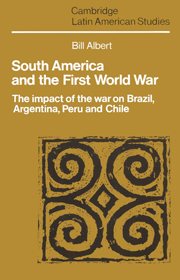Book contents
- Frontmatter
- Contents
- Tables
- Acknowledgments
- Introduction
- 1 Before the War
- 2 The early impact of the War
- 3 The recovery of trade during the War
- 4 Seeking financial solutions
- 5 The War and the growth of manufacturing industry
- 6 The War and the workers
- 7 After the War
- Notes
- Bibliography
- Index
- CAMBRIDGE LATIN AMERICAN STUDIES
5 - The War and the growth of manufacturing industry
Published online by Cambridge University Press: 22 October 2009
- Frontmatter
- Contents
- Tables
- Acknowledgments
- Introduction
- 1 Before the War
- 2 The early impact of the War
- 3 The recovery of trade during the War
- 4 Seeking financial solutions
- 5 The War and the growth of manufacturing industry
- 6 The War and the workers
- 7 After the War
- Notes
- Bibliography
- Index
- CAMBRIDGE LATIN AMERICAN STUDIES
Summary
Industrialization has been the main focus for most recent debates about the impact of the war upon Latin America. Up until the early 1960s it was assumed that the external shock delivered by the sudden and substantial reduction in imports gave a push to local manufacturing and that in these years there was a significant degree of industrial expansion based on import-substitution, at least in the more advanced of the Latin American countries. Andrá Gunder Frank, accepting this argument, used it in support of his contention that:
If it is satellite status which generates underdevelopment, then a weaker or lesser degree of metropolis–satellite relations may generate less deep structural underdevelopment and/or allow for more possibility of local development … satellites have typically managed such temporary spurts in development as they have had, during the wars and depressions in the metropolis, which momentarily weakened or lessened its domination over the life of the satellites.
In a recent summary of the work on wartime industrial development in Peru, Chile, Colombia, Brazil, and Argentina, Rory Miller explicitly challenged Frank's position and concluded that, “… in none of these five countries can the wartime period be distinguished as one of significant and lasting initiatives in manufacturing industry, but rather as one of windfall profits and limited expansion on the basis established before 1914.” This he claims was mainly because of a combination of falling real incomes, and the impossibility of importing vital capital equipment, raw materials, and semi-finished goods.
- Type
- Chapter
- Information
- South America and the First World WarThe Impact of the War on Brazil, Argentina, Peru and Chile, pp. 180 - 232Publisher: Cambridge University PressPrint publication year: 1988

